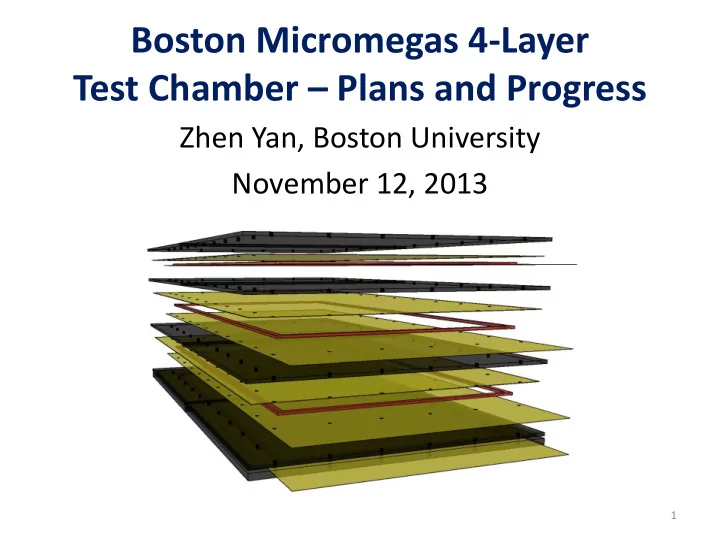

Boston Micromegas 4-Layer Test Chamber – Plans and Progress Zhen Yan, Boston University November 12, 2013 1
Boston University personnel • Steve Ahlen, Professor • Andrew Inglis, Engineering Physicist • Zhen Yan, Physicist • Mike Kruskal, Graduate Student • Emma Rosenfeld, Undergraduate Student 2
Boston 4-Layer Test Chamber • Collaboration of Boston University and Harvard University. • Four layers of Micromegas PCBs so that particle trajectories can be measured and tracking resolution can be verified. Built with solid, precision materials (± 40 m m) for precise alignment • ( the detector construction technique is optimized for studies of MM PCB performance and precision, and for evaluating MM electronics, but is not suitable for production of chambers to be used in NSW ) . • Active area = 1027 mm x 461 mm. • Project approved September 2013. • Chamber to be built at Boston University in Class 1000 cleanroom by March 2014. • Chamber will be tested at BU and sent to Harvard by May 2014. • Harvard will test chamber with VMM2 electronics using cosmic ray test stand that was set up to test BMC MDT chambers and electronics for Small Wheel. 3
BMC Test Stand at Harvard with Mod-0 in 2001 Many problems with first generation MDT electronics were found and fixed 4
BU supervised construction and testing of Small Wheel MDT Chambers at Harvard 5
Design of one layer of MM chamber 6
Micromegas PCB Construction of 4 boards begins at CERN this week • Designed by Andrew Inglis and Givi Sekhniaidze • Overall dimensions 1260 mm x 533 mm • Active area (black area shown below) 1027 mm x 461 mm Cu/resistive strip pitch = 450 m m • Cu/resistive strip width = 300 m m • Pillars: diameter = 300 m m, spacing = 7.07 mm • 7
MM PCBs will be glued to machine ready aluminum blanks on granite table. PCB will extend over edge to allow space for connectors. Top and side views below. 8
Alignment Plan (details to be determined) • Horizontal PCB surfaces will be made parallel with uniform separation distances by using shims, based on mechanical measurements on granite table. • Resistive strip positions will be measured relative to aluminum blank edges from photographs with 40 Mpixel medium format camera (see slides below). • Measurements of horizontal positions of PCB support blanks will be made with standard mechanical instruments on granite table of aluminum blank edges. • Data on horizontal positions will be used to determine precision trajectories from MM DAQ data. 9
Drift gap = 5 mm; bottom Al plate thickness = 12.7 mm; top 4 Al plate thicknesses = 6.3 mm 10
Materials, frame stretcher, have been received 11
12
13
BU Cleanroom 14
New granite table for chamber construction 15
BU Cleanroom environmental data 16
Other MM activities at BU • Measure positions of resistive strips using 40 Megapixel Medium Format CCD camera (Pentax 645D with FA645 55mm f/2.8 lens). • Measure positions of copper strips with x-rays. • Study electrical discharges with transparent chamber cover plate and single photon sensitive full frame 18 Megapixel CMOS camera (Canon EOS-1D X with EF 35mm f/1.4 lens). 17
18
Photograph of resistive strips; lens distortions are eliminated by taking photos of precision ruler (precision of strip measurements verified to be better than 20 m m over 250 mm). 19
20
21
X-ray of MM; 100 keV; 43 cm x 35 cm; selection box shown was moved along vertical line of pixels; 100 microns/pixel 22
Summary • BU Cleanroom was set up with University funding in 2012 in anticipation of proposal for MM construction site in collaboration with Brandeis and Harvard. • US budget decisions and cuts have reduced scope of initial plan. • Approval and funding for this de-scoped project began September 2013. • BU will build 4-layer, 1 m x 0.46 m MM chamber, with precision alignment that will be delivered to Harvard in May 2014 for cosmic ray and electronics testing. • BU will complete optical survey of resistive strips and x-ray survey of copper strips on current BU MM PCB by January 2014. • BU will study electrical discharges with single-photon sensitive camera to study cleanliness and assembly specifications for MM chambers (to be completed April 2014). 23
Recommend
More recommend